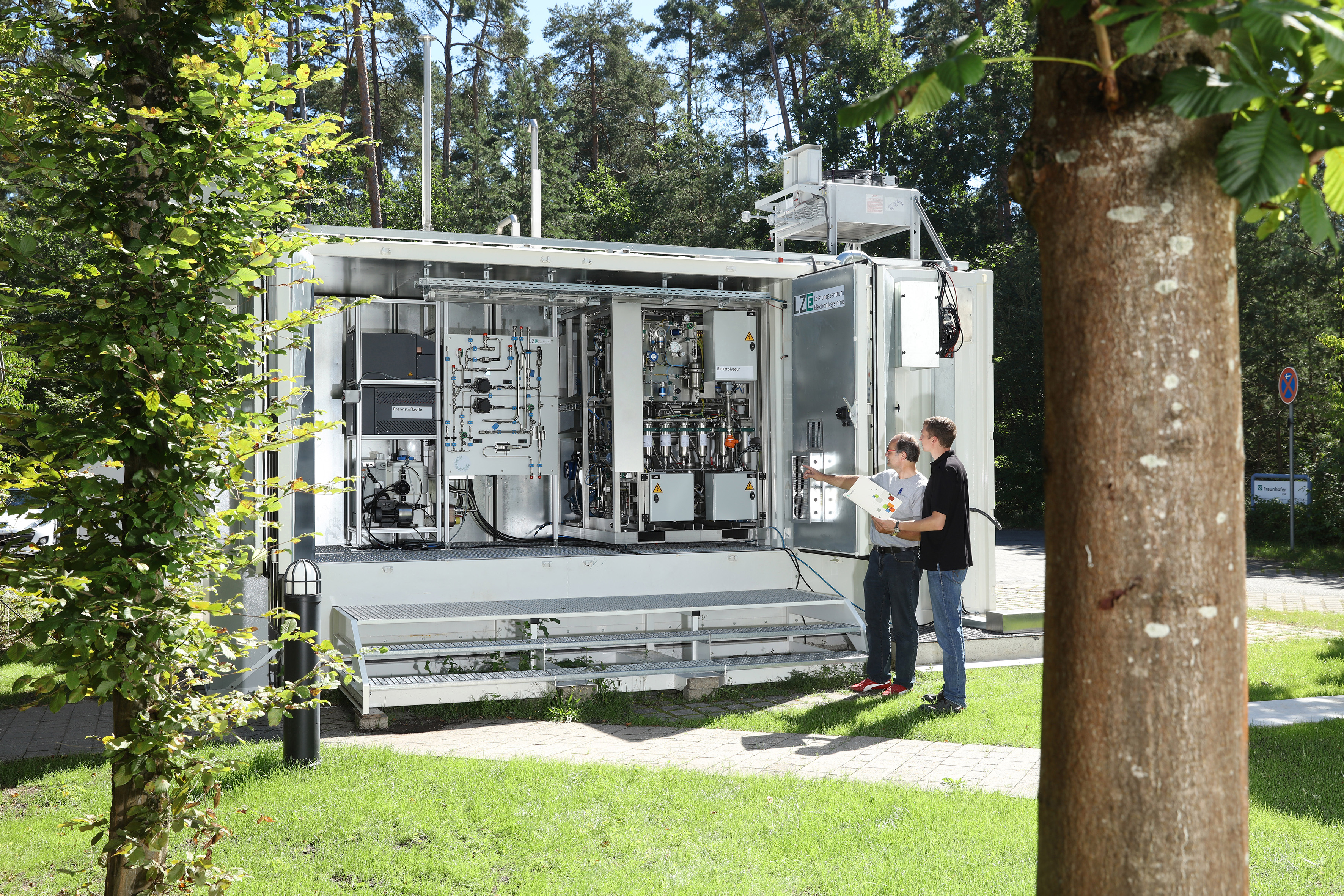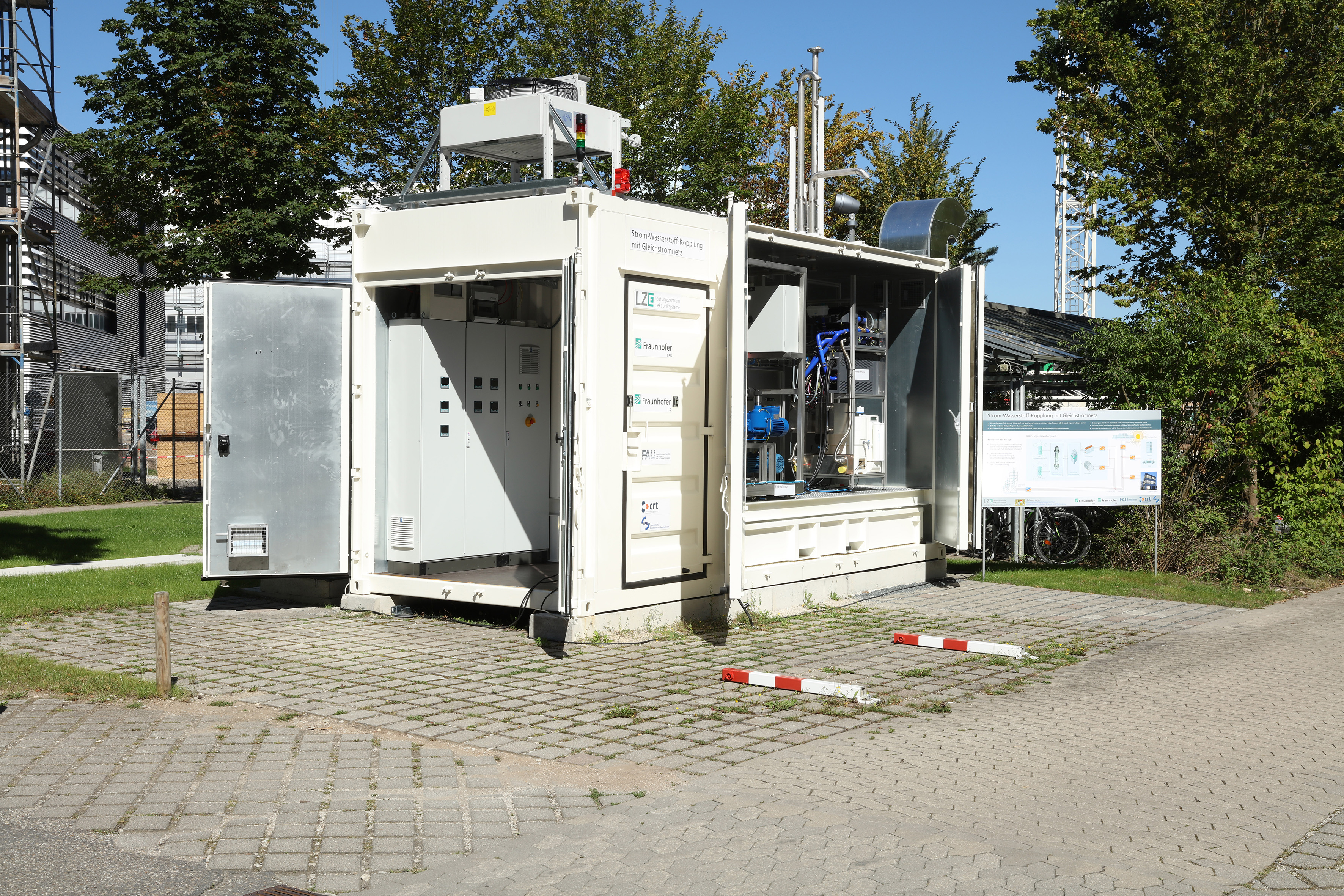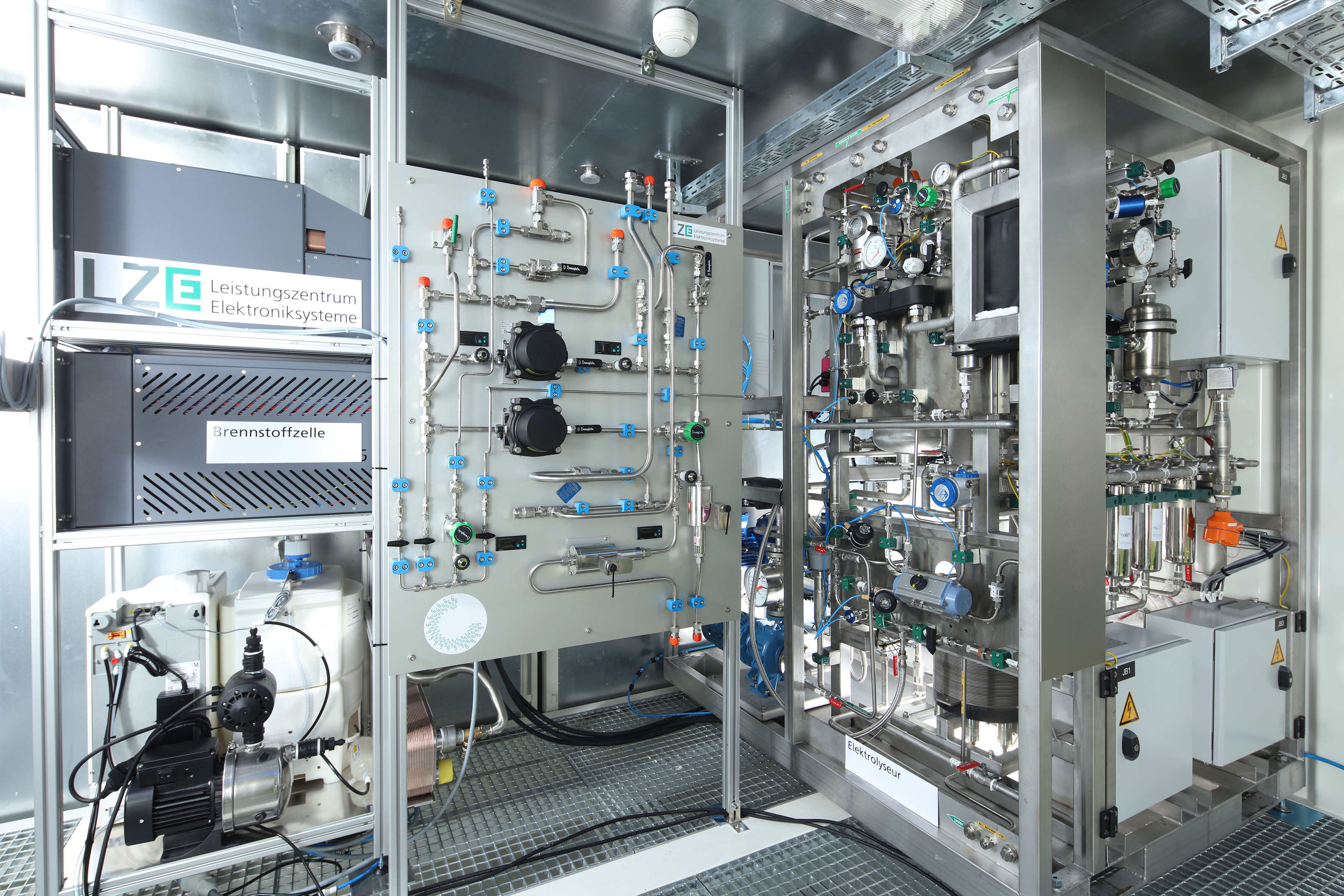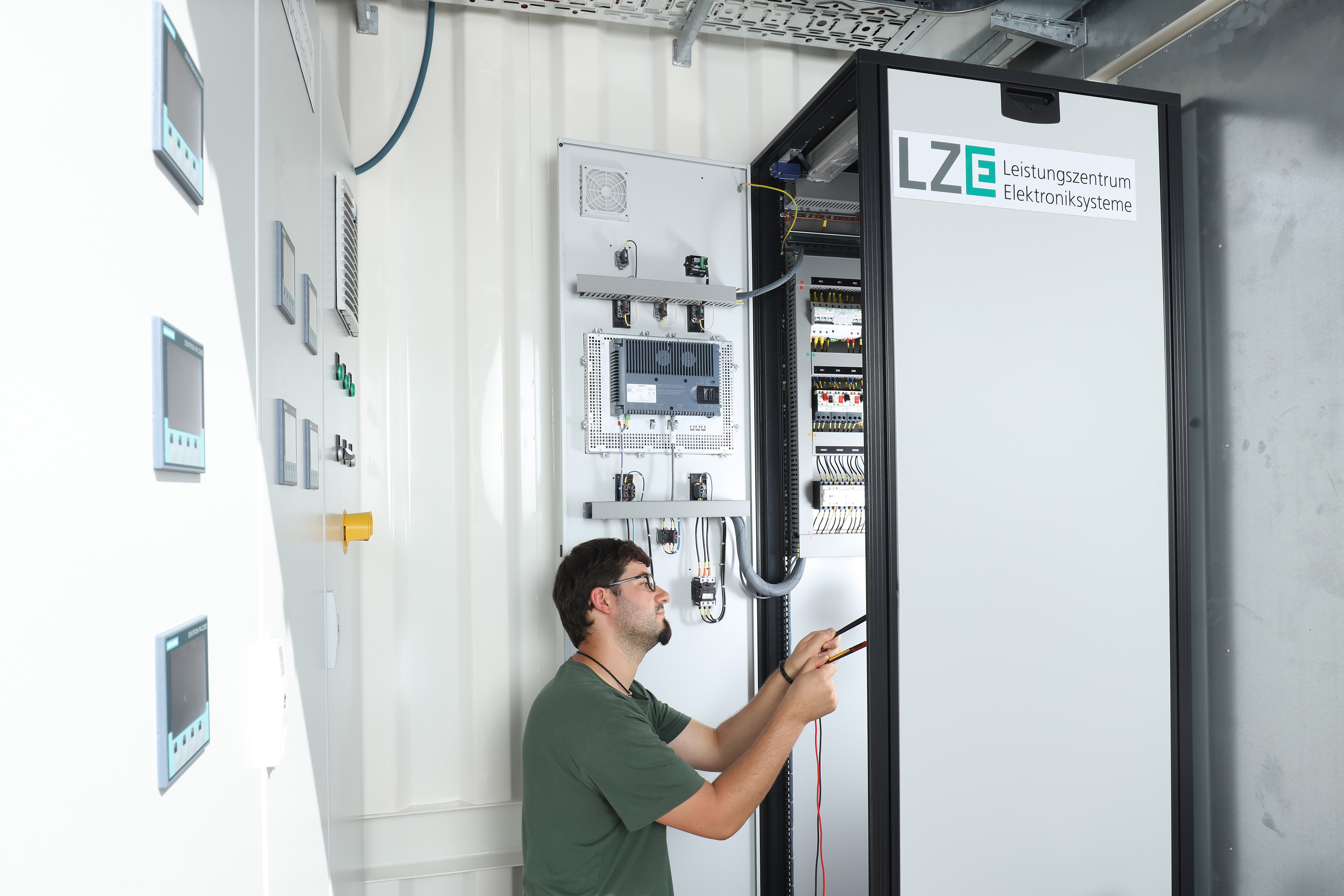Leistungszentrum Elektroniksysteme builds long-term storage with hydrogen technology
A globally unique system for the compact storage of huge amounts of energy is set up at Fraunhofer IISB in Erlangen and integrated in a modern direct current grid. In the framework of the joint initiative Leistungszentrum Elektroniksysteme LZE, it is investigated how such energy storage systems can contribute to a safe and clean energy supply of industrial plants and larger building complexes.


Entering the white steel container at Fraunhofer Institute for Integrated Systems and Device
Technology IISB in Erlangen, it can get a little tight. The interior is packed with technology that
enables the storage and release of electrical energy based on a liquid hydrogen carrier.
“The goal was to place all components of the process in a 20 ft container,” explains Johannes Geiling. He works as research assistant at Fraunhofer IISB and is responsible for the setup of the process part of the new energy storage system. The plant is set up in the framework of the LZE and is intended to set benchmarks for the long-term storage of huge amounts of energy – by requiring extremely less space. The basic concept of the storage system is to use excess energy, e. g., from a local photovoltaic plant, to produce hydrogen und to store this hydrogen safely and compactly within an organic carrier – even for longer periods up to seasonal storage. For the later use, the hydrogen can be released from the carrier and converted into electrical energy by using a fuel cell. With the installed components, 25 kilowatts of electrical power can be stored and released from the storage system. The used fuel cell system is based on the low-temperature PEM technology (PEM: Proton Exchange Membrane). The PEM technology makes it possible to set the fuel cell from the off state to standby within a few minutes. Fast availability, for example, is important for covering load peaks at industrial plants at a later time.
The carrier material used for the hydrogen storage is known as LOHC (liquid organic hydrogen carrier) in technical language. The researchers in Erlangen see a great potential in the use of LOHC technology, in which the Institute of Chemical Reaction Engineering (CRT) at the University of Erlangen-Nürnberg has a lot of expertise. During a chemical reaction, huge amounts of electrolytically produced hydrogen are bound on the carrier molecule. The reaction product, which contains the hydrogen, can be stored safely under common ambient conditions for pressure and temperature. Only under defined conditions inside a chemical reactor can the hydrogen be released from the carrier. Regarding the require- ments for storage and transport, the carrier can be compared to common diesel, which means a big advantage compared to other hydrogen storage technologies, which usually need high pressure or very low temperatures. In addition, the carrier material is widely used in industrial processes as thermal oil in heating and cooling processes. Applied as LOHC, the carrier material enables the repeated storage and release of energy in a cycle process. In contrast to fossil fuels, the LOHC is not consumed during the process but can be repeatedly loaded and unloaded with hydrogen.
About 300 liters of LOHC can be stored inside the container in Erlangen, which corresponds to an energy amount of nearly 600 kilowatt hours stored in the hydrogen. This is enough to cover the electricity demand of smaller industrial plants for a few hours. Via additional tank containers, the stored amount of energy can be increased by several magnitudes. Therefore, even larger industrial plants, data centers, or hospitals can be supplied over longer time periods.


With the new demonstration system, the researchers in Erlangen want to answer several questions: How can LOHC-based energy storage systems deal with fluctuating energy generation profiles? How can the compact setup be realized within a single container? And how can such a system be efficiently integrated in industrial energy systems? At Fraunhofer IISB, the system is connected to the local direct current (DC) grid. Local DC grids enable a more efficient operation of the whole electrical system due to the avoidance of conversion losses between direct current and alternating current.
Because of the extreme compactness of the container system, a large variety of customized solutions was necessary. “Only through interdisciplinary cooperation can our research project be managed successfully,” explains deputy project manager Michael Steinberger. The electrical engineer has become a specialist in fuel cells over the last years and is also responsible for the control system in the container.
For the conception of the control system, Steinberger received valuable support from communication experts at the Fraunhofer Institute for Integrated Circuits IIS. However, deep knowledge of chemical processes is also necessary. For example, the chemical reactor for the release of hydrogen stored in LOHC is a development of the Institute of Chemical Reaction Engineering at the University of Erlangen-Nürnberg, which is a project partner within the framework of the Leistungszentrum Elektroniksysteme LZE.
The research activities on the globally unique energy storage system are leading to important knowledge of how such systems can be integrated in local energy systems. “An important focus of our work is to find the best operational strategy for the storage system,” says IISB researcher Johannes Geiling. With the right operational strategy, the LOHC-based energy storage system will enable the extensive integration of renewable energy sources while ensuring security of supply in industrial plants, larger building complexes, or quarters, and thereby increase the degree of energy self-sufficiency.
About the Leistungszentrum Elektroniksysteme
The Leistungszentrum Elektroniksysteme (LZE) is a joint initiative of the Fraunhofer-Gesellschaft, its institutes IIS and IISB, and the Friedrich-Alexander-Universität Erlangen-Nürnberg (FAU), together with other non-university research institutions and associated partners from industry. The LZE / "Center of Excellence for Electronic Systems" is based on many years of intensive cooperation between the Fraunhofer institutes and the FAU, as well as the unique concentration of research and industry in the field of electronic systems at the Nuremberg-Erlangen-Fürth region.
Excellent research and joint planning create the basis for a comprehensive, long-term strategic partnership between Fraunhofer, FAU and industry. The pilot phase of the LZE was launched in January 2015 and is funded by the Bavarian State Ministry of Economic Affairs and Media, Energy and Technology.
Further activities of Fraunhofer IISB in the field of hydrogen: Hydrogen in intelligent energy systems @ IISB
Further information as well as the pilot projects of the LZE e.V. can be found at: http://www.lze.bayern.
Last modified:
 Fraunhofer Institute for Integrated Systems and Device Technology IISB
Fraunhofer Institute for Integrated Systems and Device Technology IISB